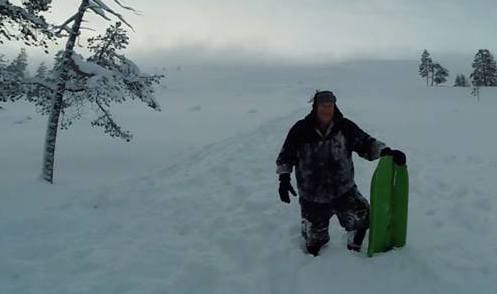
On March 17, St Patrick’s Day, a once in a decade solar storm caused a massive flare-up of solar radiation. The Northern Lights danced over Donegal, a curtain of gentle green edged with red and purple. Above bare Ben Bulben the Aurora Borealis swayed and shimmered in an ethereal celebration of indomitable Irishry.
The last time I saw the northern lights was on Christmas Eve. I was a few hours’ drive above the Arctic Circle in Finnish Lapland, where I spend all my winters. Around midnight, after a beer or three, a group of us decided to climb a nearby peak and toboggan down in the darkness. It seemed like a good idea at the time.
The temperature outside was a brisk minus 25, and the snow crunching beneath our boots was the only sound in the solitude. Every time we took a breath the delicate hairs inside our nostrils would freeze for a second, then thaw as we exhaled. This ticklish sensation is one of the things you become very familiar with in the Arctic. Crystals of condensation froze in the air, glittering in the moonlight like stars.
We were near the top of the hill when the sky ahead of us suddenly glowed green. It began like the glow of car headlights on the other side of a hill, lightening the sky. But then two pillars of vivid green shot into the air, and danced to the left, billowing across the horizon until most of the sky was covered. Then the lights began to move rapidly, wave after wave of green undulating, glowing, fading, glowing again. The light was so bright that the snow took on a green hue. All of us, without a word, dropped down and lay on our backs on the cold ground, watching mesmerized. The display lasted close to an hour, taking up more than half of the dome of the sky. Through it the band of the Milky Way could be seen pin pricking the sky, adding texture to the display.
Slowly it faded, and one by one we got up and tobogganed blindly down the slope. I lost my phone. A friend lost his gloves and camera. No one cared.
It never gets stale. I have seen the Northern Lights dozens of times, and each time I am filled with the same primitive wonder. I can understand what draws people to the Polar Regions, because I feel the pull.
It doesn’t matter why we come here first. Some, like Robert Peary and Roald Amundsen, were drawn by the mythology and the lore of the pole. Some, like Richard Byrd, were drawn by the chance of fame and advancement. Some, like Frederick Cook, came to escape the problems of lower latitudes. But whatever impels us to come here first, we return because it gets into our soul.
The search for the North Pole drew all sorts of men. It drew heroes like Amundsen, good-natured bunglers and corner-cutters like Cook, autocratic cheats like Peary, and opportunists like Byrd. Different personalities and different motivations, but what united them all was the love of the frozen regions, the last frontier of human exploration.
In my book ‘The Great Polar Fraud’ I tried to separate the myths from the reality, and tell the story in full for the first time, of the first four men to claim the North Pole. Three cheated and fell short; the fourth got there and died without ever realizing he was actually the first. When you understand their motivations it is difficult not to feel sympathy and respect even for the three cheats. They were men following a glorious dream.
Someday I hope to step foot on the pole myself. It is on my bucket list, and I am a stubborn man. I will get there. When I do, I will be following in the footsteps of giants.
Anthony Galvin is the writer of The Great Polar Fraud: Cook, Peary, and Byrd - How Three American Heroes Duped the World into Thinking They Had Reached the North Pole. Out now and published by Skyhorse Publishing.
“I’ve learned so much since joining Creative Authors in 2012. Isy’s negotiated well over twenty book deals for me since then and has always been very supportive. Her advice and knowledge of the publishing world have been invaluable in helping me progress as a writer and illustrator.”
Ged Adamson, Creative Authors Client